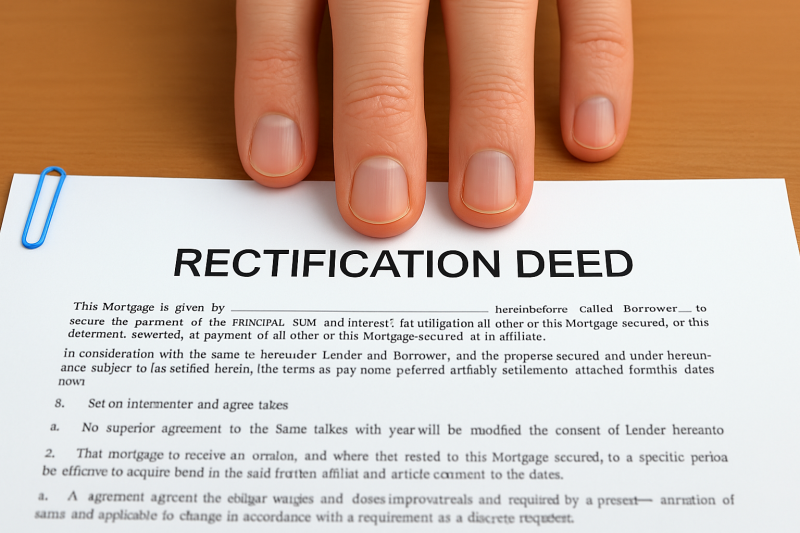- May 27, 2025
-
How to Correct Mistakes in Your Property Deed: A Complete Guide
When it comes to real estate, accuracy is everything. Even a small mistake in your property deed—like a wrong name, a typo in the survey number, or incorrect boundary info—can cause big trouble during resale, registration, or legal verification.
Thankfully, these errors are fixable. Let’s explore the common issues, how to legally correct them, and the exact steps to register a rectification deed.
Why Do Property Deed Mistakes Happen?
Mistakes in property documents are more common than you think, especially in older deeds. Most occur due to:
- Manual entry errors during registration
- Incorrect or incomplete information from parties
- Translation mistakes (English vs. Tamil)
- Clerical slips in ownership history or survey numbers
Common Errors in Property Deeds:
- Misspelled or wrong owner names
- Incorrect father/husband name
- Missing or mis-recorded boundary details
- Old survey numbers not updated
- Date of execution mismatch
- Property area shown incorrectly
⚠️ Ignoring these errors could delay future registrations, affect resale, or even lead to ownership disputes.
Common Concerns & Legal Solutions
Let’s address the most frequently asked questions when it comes to deed corrections.
What If the Seller Is No Longer Alive?
If the seller has passed away:
- You need a No Objection Certificate (NOC) or written consent from their legal heirs.
- If heirs can't be traced or won’t cooperate, you may need a civil court order to authorize the correction.
👨⚖️ Best Practice: Get a legal heir certificate and consult a property lawyer.
What If the Property Boundaries Are Wrong?
Incorrect border info must be corrected through a Rectification Deed.
Steps:
- Re-measure the property using a licensed surveyor (FMB sketch or DGPS recommended)
- Draft the correction deed clearly stating the accurate measurements
- Get signatures from both buyer and seller (or their legal heirs)
- Register it at the Sub-Registrar’s Office
📐 Precise boundaries protect you from encroachment and litigation.
How to Correct My Father’s Name in the Deed?
If your father’s name is listed incorrectly:
- Submit a correction application at the SRO office
- Provide supporting ID proofs (Aadhaar, Voter ID, etc.)
- Attach original deed, EC, and an affidavit confirming the correct name
- File a Rectification Deed if the mistake is in a registered document
📝 This is crucial for future legal heir claims or Patta transfers.
What If a Family Member Refuses to Sign the Correction?
If the property is jointly held or inherited, and a family member refuses to approve a correction:
- Try family mediation or issue a legal notice
- As a last resort, approach the civil court for an order permitting the rectification
👨👩👧👦 Unresolved errors may impact future generations and inheritance rights.
How to Fix Mistakes in an Old Deed (e.g., from 1990)?
- Obtain a certified copy of the original deed from the Sub-Registrar Office
- Draft a Rectification Deed highlighting the incorrect and corrected parts
- Have it signed by both parties (or their heirs)
- Register the new deed as a correction document
🧾 You may also include notarized affidavits if the original parties are not traceable.
Steps to Rectify Property Deed Mistakes
Here’s your complete step-by-step process for legal deed correction in Tamil Nadu (or most Indian states):
✅ Step 1: Identify the Error
Carefully examine the Sale Deed or Gift Deed and note the incorrect entries.
✅ Step 2: Gather Supporting Proof
Collect all documents that confirm the correct data, like:
- Aadhaar card, PAN, Voter ID
- Legal heir certificate (if applicable)
- Patta/FMB sketch
- EC (Encumbrance Certificate)
✅ Step 3: Draft a Rectification Deed
Prepare the correction document using a legal format. It must include:
- Reference to the original deed
- Description of the error
- Corrected information
- Signatures of all parties (buyer, seller, witnesses)
✅ Step 4: Register the Rectification Deed
- Visit the Sub-Registrar Office (SRO)
- Pay the nominal stamp duty (usually ₹100–₹500)
- Submit and get the deed registered officially
🧠 Keep both the original and the rectification deed safe for future transactions.
Summary: Fix It Now, Avoid Future Headaches
Errors in property deeds may seem small, but they can turn into major legal roadblocks over time. Whether it’s a misspelled name or inaccurate boundary details, correcting them through a registered rectification deed is the safest and smartest option.
🛑 Don’t ignore errors—fix them legally today and protect your property tomorrow.
FAQs – Property Deed Corrections
Q1: Is there a deadline for correcting a property deed?
No official time limit, but the sooner, the better—especially before resale or legal transfer.
Q2: Can I correct a deed without the seller’s presence?
Only in specific cases like:
- The seller is deceased, and legal heirs provide consent
- A court order authorizes the correction
Q3: What is the cost of registering a rectification deed?
Typically around ₹100 to ₹500 (stamp duty), plus document writer/notary fees.
Q4: Is a rectification deed valid in court?
Yes, a registered rectification deed holds full legal validity and is accepted as part of the title record.


Comments :
Currently, there are no comments in this post. Be the first person to comment on this post.